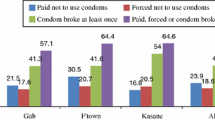Abstract
Objective: To examine the contribution of patterns of sexual partnering to the spread of HIV/STD infection between communities.
Methods: 651 randomly selected Aboriginals from 11 reserve communities in Ontario were interviewed. This analysis included those who had sex in the previous 12 months. Descriptive statistics and multivariate analyses identified associations with patterns of sexual partnering.
Results: 22% reported having partners from both within and outside the community, 51% from within only, and 27% from outside only. Those with partners from both within and out-side were more likely to be male, unmarried, from a remote community, have more sexual partners and perceive that their behaviour placed them at higher risk of HIV/STD infection. They were least likely to perceive their community to be at risk from their behaviour.
Conclusions: Findings suggest that Aboriginal communities are not insulated and that HIV could spread rapidly if introduced.
Résumé
Objectif: examiner la contribution des types de partenariat sexuel à la propagation du VIH et des MTS entre les communautés.
Méthodes: 651 Autochtones choisis au hasard dans 11 communautés des réserves de l’Ontario ont été interviewés. L’analyse comprenait les individus ayant eu des relations sexuelles au cours des 12 mois précédents. Les statistiques descriptives et les analyses multi-variées ont identifié des associations selon les types de partenariat sexuel.
Résultats: 22% ont déclaré avoir eu des partenaires tant au sein qu’à l’extérieur de la communauté, 51% au sein de la communauté seulement, et 27% à l’extérieur de la communauté seulement. Les individus ayant eu des partenaires tant à l’intérieur qu’à l’extérieur de la communauté étaient plus souvent des hommes, célibataires, venant d’une communauté éloignée, qui étaient plus susceptibles d’avoir davantage de partenaires sexuels et de penser que leur comportement leur faisait courir des risques plus élevés d’être infectés par des MTS et le VIH. Ils étaient aussi les moins susceptibles de percevoir le risque qu’ils faisaient courir à leur communauté par leur comportement.
Conclusions: les résultats suggèrent que les communautés autochtones ne sont pas isolées contre le risque et que le VIH pourrait rapidement se propager s’il était introduit.
Similar content being viewed by others
References
Joint National Committee on Aboriginal AIDS Education and Prevention. Recommendations for a National Strategy on Aboriginal AIDS Education and Prevention. Ottawa: Health Canada, 1990.
Jolly AM, Orr PH, Hammond G, Young TK. Risk factors for infection in women undergoing testing for Chlamydia trachomatis and Neisseria gonorrhoeae in Manitoba, Canada. Sex Transm Dis 1995;22(5):289–95.
Nguyen M, Archibald CP, Sutherland D, Wilk T. Aboriginal HIV/AIDS in Canada. (Abstract TuD. 2630) Presented at the XIth International Conference on AIDS, Vancouver, 1996, July 6–11.
Calzavara L, Strike C, Yan P. Epidemiologic review: AIDS and HIV among Aboriginal people in Canada. Quarterly Surveillance Update: AIDS in Canada. Ottawa: Division of HIV/AIDS Epidemiology, Laboratory Centre for Disease Control, Health Canada, 1994; April: 26–33.
Rekart M. Trends in HIV seroprevalence among street-involved persons in Vancouver, Canada (Abstract PO-C21-3105). Presented at the IXth International Conference on AIDS, Berlin, 1993, June 6–11.
Rothon D, Mathias R, Schechter M. Prevalence of HIV infection in provincial prisons in British Columbia. Can Med Assoc J 1994;151(6):781–87.
Hammond G, Buchanan D, Malazdrewicz R, et al. & The Manitoba AIDS Virus Epidemiology Study (MAVES) Group. Seroprevalence and demographic information of patients at risk for Human Immunodeficiency Virus (HIV) infection in Manitoba, Canada. J Acquir Immune Defic Syndr 1988;1:138–42.
Myers T, Calzavara LM, Cockerill R, et al. & First Nations Steering Committee. Ontario First Nations AIDS and Healthy Lifestyle Survey. Ottawa: National AIDS Clearinghouse, Canadian Public Health Association, 1993.
Conway GA, Ambrose TJ, Chase E, et al. HIV infection in American Indians and Alaska Natives: Surveys in the Indian Health Service. J Acquir Immune Defic Syndr 1992;5:803–9.
Hall RL, Wilder D, Bodenroeder P, Hess M. Assessment of AIDS knowledge, attitudes, behaviors, and risk level of Northwestern American Indians. Am J Public Health 1990;80(7):875–77.
Meder R, Conway GA, Stehr-Green J. AIDS surveillance among American Indians and Alaska Natives. Am J Public Health 1991;81(11):1469–71.
Michael R, Gagnon J, Laumann E, Kolata G. Sex in America: A Definitive Survey. Boston: Little, Brown and Company, 1994.
Department of Indian Affairs and Northern Development. Indian Register: Population by Sex and Residence. Ottawa: QS-5087-00-BB-A17, 1993.
Myers T, George C, Calzavara LM, et al. The Ontario First Nations AIDS and Healthy Lifestyle Survey: A model for community-based research in diverse communities. Arctic Med Res 1994;53(suppl. 2):726–31.
Diaz T, Chu SY, Conti L, et al. Risk behaviors of persons with heterosexually acquired HIV infection in the United States: Results of a multistate surveillance project. J Acquir Immune Defic Syndr 1994;7(9):958–63.
SAS Institute. SAS User’s Guide: Statistics, Version 5 Edition. Cary, North Carolina: The SAS Institute, 1985.
Maticka-Tyndale E, Herold E, Mewhinney D. Casual Sex and Condom Use on Spring Break Vacation: Implications for HIV Prevention Programming (Abstract 132). Presented at the 6th Annual Canadian Conference on HIV/AIDS Research, Ottawa, 1997, May 22–25.
Myers T, Bullock SL, Calzavara LM, et al. Culture and sexual practices in response to HIV among Aboriginal people living on-reserve in Ontario. Culture, Health & Sexuality 1999;1(1), in press.
Author information
Authors and Affiliations
Corresponding author
Additional information
This project was co-funded by the Health Care Systems Research Program, Ontario Ministry of Health, and the AIDS Information and Education Services Contribution Program, Health Canada.
Drs. Calzavara and Myers are National AIDS Health Scholars, National Health Research and Development Program (NHRDP), Health Canada, and Ms. Bullock is a NHRDP PhD Fellow.
Rights and permissions
About this article
Cite this article
Calzavara, L.M., Bullock, S.L., Myers, T. et al. Sexual Partnering and Risk of HIV/STD Among Aboriginals. Can J Public Health 90, 186–191 (1999). https://doi.org/10.1007/BF03404504
Received:
Accepted:
Published:
Issue Date:
DOI: https://doi.org/10.1007/BF03404504



